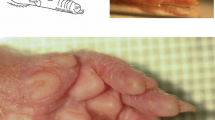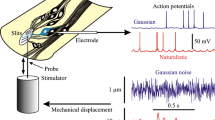Abstract
The population response of rapidly-adapting (RA) fibers is one component of the physiological substrate of the sense of touch. Herein, we describe a computational scheme based on the population-response model by K.O. Johnson (J. Neurophysiol. 37: 48–72, 1974) which we extended by permitting the capability to include the spatial distributions of receptors in the glabrous skin linked to RA fibers. The hypothetical cases simulated were rectangular, uniformly random and proximo-distally Gaussian distributions. Each spatial organization produced qualitatively distinct population-response profiles that also varied due to stimulus parameters. The effects of stimulus amplitude, average innervation density and contactor-probe location were studied by considering various response measures: number of active fibers, summated firing rate and the average firing rate of a subset of the modeled population. The outcome of the measures were statistically compared among simulated anatomical distributions. The response is the same for rectangular and uniformly random distributions, both of which have a homogeneous innervation density. However, the Gaussian distribution produced statistically different responses when the measure was not averaged over the subset population which represented the receptive field of a higher-order neuron. These results indicate that, as well as stimulus parameters, the anatomical organization is a significant determinant of the population response. Therefore, reconstructing population activity for testing psychophysical hypotheses must presently be done with care until the organization of the receptors within the skin has been clarified.
Similar content being viewed by others
References
Armett CJ, Gray JAB, Hunsperger RW, Lal S (1962) The transmission of information in primary receptor neurones and second-order neurones of a phasic system. J. Physiol. 164: 395–421.
Bolanowski SJ (1996) Information processing channels in the sense of touch. In: O Franzen, R Johansson, L Tarenius, eds. Wenner-Gren International Series: Somesthesis and the Neurobiology of the Somatosensory Cortex. Birkhäuser, Basel. pp. 49–58.
Bolanowski SJ, Gescheider GA, Verrillo RT, Checkosky CM(1988) Four channels mediate the mechanical aspects of touch. J. Acoust. Soc. Am. 84: 1680–1694.
Bolanowski SJ, Pawson L, Dishman JD (2000) The organization of Meissners and Merkels in cat and monkey glabrous skin. Soc. Neurosci. Abstr. 26: 426.
Bolanowski SJ, Pawson L, Verrillo R (1999) Tactile receptor responses to vibratory stimuli placed on and around their receptive-field centers. Soc. Neurosci. Abstr. 25: 407.
Bolton CF, Winkelmann RK, Dyck PJ (1966) A quantitative study of Meissner's corpuscles in man. Neurology 16: 1–9.
Bystrzycka E, Nail BS, Rowe M (1977) Inhibition of cuneate neurones: Its afferent source and influence on dynamically sensitive ‘tactile’ neurones. J. Physiol. 268: 251–270.
Cauna N (1956) Nerve supply and nerve endings in Meissner's corpuscles. Am. J. Anat. 99: 315–350.
Cauna N (1959) The mode of termination of sensory nerves and its significance. J. Comp. Neur. 113: 169–210.
Cauna N (1965) The effects of aging on the receptor organs of the human dermis. In:W Montagna, ed. Advances in Biology of Skin Vol. VI: Aging. Pergamon, Oxford. pp. 63–96.
Costanzo RM, Gardner EP (1980) A quantitative analysis of responses of direction-sensitive neurons in somatosensory cortex of awake monkeys. J. Neurophysiol. 43: 1319–1341.
Craig JC (1976) Attenuation of vibrotactile spatial summation. Sens. Proc. 1: 40–56.
Darian-Smith I, Davidson I, Johnson KO (1980) Peripheral neural representation of spatial dimensions of a textured surface moving across the monkey's finger pad. J. Physiol. 309: 135–146.
Darian-Smith I, Kenins P (1980) Innervation density of mechanoreceptive fibres supplying glabrous skin of the monkey's index finger. J. Physiol. 309: 147–155.
Darian-Smith I, Oke LE (1980) Peripheral neural representation of the spatial frequency of a grating moving across the monkey's finger pad. J. Physiol. 309: 117–133.
DiCarlo JJ, Johnson KO (1999) Velocity invariance of receptive field structure in somatosensory cortical area 3b of the alert monkey. J. Neurosci. 19: 401–419.
DiCarlo JJ, Johnson KO (2000) Spatial and temporal structure of receptive fields in primate somatosensory area 3b: Effects of stimulus scanning direction and orientation. J. Neurosci. 20: 495–510.
DiCarlo JJ, Johnson KO, Hsiao SS (1998) Structure of receptive fields in area 3b of primary somatosensory cortex in the alert monkey. J. Neurosci. 18: 2626–2645.
Dykes RW(1983) Parallel processing of somatosensory information: A theory. Brain Res. Rev. 6: 47–115.
Fuller DRG, Gray JAB (1966) The relation between mechanical displacements applied to a cat's pad and the resultant impulse patterns. J. Physiol. 182: 465–483.
Gardner EP, Spencer W (1972a) Sensory funneling. I. Psychophysical observations of human subjects and responses of cutaneous mechanoreceptive afferents in the cat to patterned stimuli. J. Neurophysiol. 35: 925–953.
Gardner EP, Spencer W (1972b) Sensory funneling. II. Cortical neuronal representation of patterned cutaneous stimuli. J. Neurophysiol. 35: 954–977.
Gescheider GA, Capraro AJ, Frisina RD, Hamer RD, Verrillo RT (1978) The effects of a surround on vibrotactile thresholds. Sens. Proc. 2: 99–115.
Goodwin AW, Browning AS, Wheat HE (1995) Representation of curved surfaces in responses of mechanoreceptive afferent fibers innervating the monkey's fingerpad. J. Neurosci. 15: 798–810.
Goodwin AW, Macefield VG, Bisley JW (1997) Encoding of object curvature by tactile afferents from human fingers. J. Neurophysiol. 78: 2881–2888.
Goodwin AW, Pierce ME (1981) Population of quickly adapting mechanoreceptive afferents innervating monkey glabrous skin: Representation of two vibrating probes. J. Neurophysiol. 45: 243–253.
Goodwin AW, Wheat HE (1999) Effects of nonuniform fiber sensitivity, innervation geometry, and noise on information relayed by a population of slowly adapting type I primary afferents from the fingerpad. J. Neurosci. 19: 8057–8070.
Goodwin AW, Youl BD, Zimmerman NP (1981) Single quickly adapting mechanoreceptive afferents innervating monkey glabrous skin: Response to two vibrating probes. J. Neurophysiol. 45: 227–242.
Gray JAB (1966) The representation of information about rapid changes in a population of receptor units signalling mechanical events. In: AVS de Reuck, J Knight, eds. Touch, Heat and Pain. Little, Brown, Boston. pp. 299–315.
Greenspan JD, Bolanowski SJ (1996) The psychophysics of tactile perception and its peripheral physiological basis. In: L Kruger, ed. Handbook of Perception and Cognition 7: Pain and Touch. Academic Press, San Diego. pp. 25–103.
Güçlü B, Bolanowski SJ (1999) Population responses of RA mechanoreceptors with hypothetical spatial distributions. Soc. Neurosci. Abstr. 25: 407.
Güçlü B, Bolanowski SJ (2001) Statistical comparison of the intensity characteristics of monkey and cat mechanoreceptive RA fibers. Soc. Neurosci. Abstr. 27, Program No: 50.4.
Johansson RS, Vallbo ÅB (1979) Tactile sensibility in the human hand: Relative and absolute densities of four types of mechanoreceptive units in glabrous skin. J. Physiol. 286: 283–300.
Johansson RS, Vallbo ÅB (1980) Spatial properties of the population of mechanoreceptive units in the glabrous skin of the human hand. Brain Res. 184: 353–366.
Johnson KO (1974) Reconstruction of population response to a vibratory stimulus in quickly adapting mechanoreceptive afferent fiber population innervating glabrous skin of the monkey. J. Neurophysiol. 37: 48–72.
Johnson KO, Hsiao SS (1992) Neural mechanisms of tactual form and texture perception. Annu. Rev. Neurosci. 15: 227–250.
Johnson KO, Lamb GD (1981) Neural mechanisms of spatial tactile discrimination: Neural patterns evoked by Braille-like dot patterns in the monkey. J. Physiol. 310: 117–144.
Juliano SL, Whitsel BL(1987)Acombined 2-deoxyglucose and neurophysiological study of primate somatosensory cortex. J. Comp. Neurol. 263: 514–525.
Kang R, Herman D, MacGillis M, Zarzecki P (1985) Convergence of sensory inputs in somatosensory cortex: Interactions from separate afferent sources. Exp. Brain Res. 57: 271–278.
Lamb GD (1983) Tactile discrimination of textured surfaces: Peripheral neural coding in the monkey. J. Physiol. 338: 567–587.
Lindblom U (1965) Properties of touch receptors in distal glabrous skin of the monkey. J. Neurophysiol. 28: 966–985.
Mountcastle VB (1957) Modality and topographic properties of single neurons of cat's somatic sensory cortex. J. Neurophysiol. 20: 408–434.
Mountcastle VB (1967) The problem of sensing and the neural coding of sensory events. In:GC Quarton, T Melnechuk, FO Schmidt, eds. The Neurosciences: A Study Program. Rockefeller Univ. Press, New York. pp. 393–408.
Mountcastle VB, Powell TPS (1959) Neural mechanisms subserving cutaneous sensibility, with special reference to the role of afferent inhibition in sensory perception and discrimination. Bull. Johns Hopkins Hosp. 105: 201–232.
Mountcastle VB, Talbot WH, Kornhuber HH (1966) The neural transformation of mechanical stimuli delivered to the monkey's hand. In: AVS de Reuck, J Knight, eds. Touch, Heat and Pain. Little, Brown, Boston. pp. 325–345.
Munger BL (1971) Patterns of organization of peripheral sensory receptors. In: WR Loewenstein, ed. Handbook of Sensory Physiology, Vol.1. Springer, Berlin. pp. 523–556.
Palmer SE (1999) Vision Science: Photons to Phenomenology. MIT Press, Cambridge, MA.
Phillips JR, Johansson RS, Johnson KO (1992) Responses of human mechanoreceptive afferents to embossed dot arrays scanned across fingerpad skin. J. Neurosci. 12: 827–839.
Phillips JR, Johnson KO (1981a) Tactile spatial resolution. II. Neural representation of bars, edges, and gratings in monkey primary afferents. J. Neurophysiol. 46: 1192–1203.
Phillips JR, Johnson KO (1981b) Tactile spatial resolution. III. A continuum mechanics model of skin predicting mechanoreceptor responses to bars, edges, and gratings. J. Neurophysiol. 46: 1204–1225.
Phillips JR, Johnson KO, Hsiao SS (1988) Spatial pattern representation and transformation in monkey somatosensory cortex. Proc. Natl. Acad. Sci. USA. 85: 1317–1321.
Sobol' IM (1974) The Monte Carlo Method. Univ. of Chicago Press, Chicago. pp. 24–30.
Talbot WH, Darian-Smith I, Kornhuber HH, Mountcastle VB (1968) The sense of flutter-vibration: Comparison of the human capacity with response patterns of mechanoreceptive afferents from the monkey hand. J. Neurophysiol. 31: 301–334.
Verrillo RT (1963) Effect of contactor area on the vibrotactile threshold. J. Acoust. Soc. Am. 35: 1962–1966.
Warren S, Hamalainen HA, Gardner EP (1986) Objective classifi-cation of motion-and direction-sensitive neurons in primary somatosensory cortex in awake monkeys. J. Neurophysiol. 56: 598–622.
Wheat HE, Goodwin AW (2000) Tactile discrimination of gaps by slowly adapting afferents: Effects of population parameters and anisotropy in the fingerpad. J. Neurophysiol. 84: 1430–1444.
Author information
Authors and Affiliations
Rights and permissions
About this article
Cite this article
Güçlü, B., Bolanowski, S.J. Modeling Population Responses of Rapidly-Adapting Mechanoreceptive Fibers. J Comput Neurosci 12, 201–218 (2002). https://doi.org/10.1023/A:1016535413000
Issue Date:
DOI: https://doi.org/10.1023/A:1016535413000




